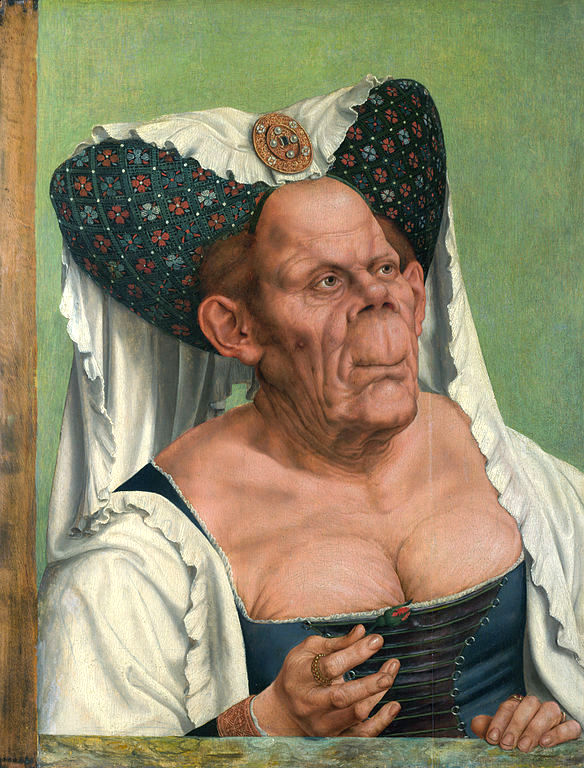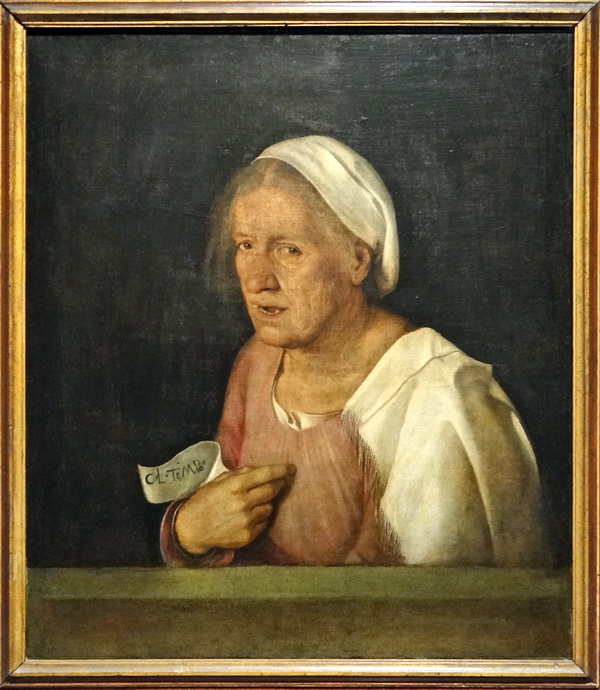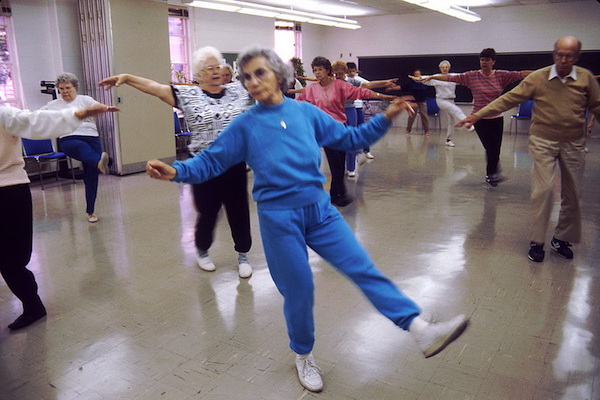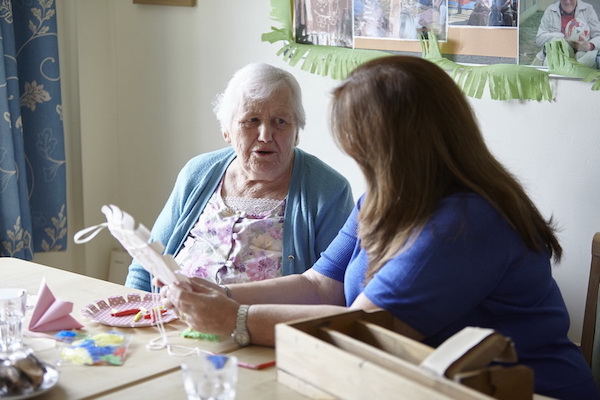Not Well Aged
“As they age, both women and men now become less visible, if at different rates and to different degrees. (It is likely that those egotistical and misogynistic men who aggressively deny that this process applies to them are driven by a repressed and powerful fear of it, just as were the men who used vanitas paintings of women as things to think themselves with.) The elderly lose their capacity to be seen both as commodities on the attractiveness and employment markets and as persons of import and autonomy. And while the old still see, few marketers, pundits, thought-leaders and business visionaries attribute great importance to what and how they see.”—William Ramp
Small Things Recollected
By William Ramp

LETHBRIDGE, ALBERTA Canada—(Weekly Hubris)—January 2018— Not well aged. Let’s begin with the dark scene above. You could be forgiven, on first glance, for mistaking Goya’s “Atropos” for a black and brown ink wash, so devoid is it of any enlivening color. It’s one of a set of Goya works known collectively as the “black paintings,” both for their hue and for the bleakness of their subject matter. This painting takes as its subject the Moirai or fates who govern the span of life: Clotho, who holds the distaff from which the living thread is spun, Lachesis who measures and spins, and Atropos, who cuts.
A fourth figure in the foreground has its hands bound, unable either to flee or to affect the making of the inexorability with which it is confronted. Death comes for all of us, the painting says, and it is not pretty. How is it measured? In progressive ugliness.
Renaissance and Baroque painting is full of depictions of Age, but Age rarely has precedent over Beauty there. Rather, it is often pretensions of age to beauty which become spectacles to be mocked, especially when those subject to such pretensions are depicted as female. The vanitas portrait was a staple of painting studios, allowing a near-effortless combination of nostrums. The first of these was piety: “Favour is deceitful, and beauty is vain: but a woman that feareth the Lord, she shall be praised.” (Proverbs 31:30, KJV). Second, prurience: nakedness and lustrous hair could be viewed without danger to one’s soul if the image imparted a moral lesson. Third, revenge: the ugly of spirit could read into such portraits the worm that would turn, the sores that would blossom, the skin that would dry and wrinkle.
There was also a sub-genre of vanitas painting devoted to the old. The tarted-up or lustful old woman was doubly-damned: both vain and deluded. A younger woman could be acknowledged, at least, as knowing her pornographic place. A vain older woman was also representable as pornographic, but the attraction she exercised was the draw of revulsion. In her brazen ugliness, which signified her dislocation from both humility and age-propriety, she was fleshly “matter out of place” (the anthropologist Mary Douglas’s classic definition of dirt). Quentin Massys’ rendition of such a woman is perhaps the cruelest image of this sort ever put to panel or canvas.

Giorgione’s portrait of an old woman, La Vecchia, has occasionally been represented as an example of this genre, but it conveys a very different message. Unlike the Massys caricature, it haunts; drawing us toward the subject’s mute appeal, inviting identification. One description of this portrait represents it (or its painter) as “defiant,” perhaps in line with a more contemporary politics. But while its subject is defiantly alive in the face of her end, whatever it may be, it is hard to read her as secure in that defiance. She knows, and fears, her fate; she knows also what she has lost and is losing. She is tagged with a paper label bearing the phrase “Col Tempo.” She is in and with Time; the painting measures her fate, even as it itself is measured. Its physical condition now adds to the message: rubbed and worn, it enhances the materiality of the pathos it conveys.

But a word is necessary here about he who reads the painting. Unthinkingly, I have fallen in with a long line of male interpreters who, as Erin Campbell notes, have put such images of women to “work to negotiate the losses and fears of men.” In her reading, the represented losses of women allow male spectators to deal with and objectify their own fears of growing old: threats to “male virility, creativity and power.” Guilty as charged. Aging is desperately unequal and lays its victims open to exploitation.
Yet its end is democratic. Death is its end, and death comes for all.
Now, let’s look at a representation of male aging by one of its most famous exponents.
Rembrandt’s 1669 self-portrait, painted in the very year of his death, is one of many he did over his lifetime, charting the increasing puffiness and gravity-pulled realities of his temporal flesh. These portraits are—or, at least, are now read—as personal, reflecting the inner spirit of the artist rather than a set of theological, moral, or social conventions.
And the way they represent the aging process is interpreted very differently than many early-modern portraits of women. Indignity accompanies the pathos of age for female subjects but, for Rembrandt, it brings gravitas, wisdom, knowledge, dignity. His sagging flesh, so tellingly painted, becomes immaterial; a mere covering for the inner male soul. He gets to practice “the art of growing old gracefully.” How deeply unfair! One review of the painting, which extols precisely these virtues, does manage a sharp and telling observation: “[t]he painting is full of pride beneath all his suffering; perhaps pride in his suffering—and pride in his art, which can make his image live like this.” The man can still make stuff.

Men are still advantaged by both the representations and the realities of aging today. The old prejudices about beauty and vanity still live (think of the denigrating connotations attached to the term “cougar,” for example), having been adapted handily to a secular age, as has the old schadenfreude. As they age, women go from being too visible to harassers on the street, to condescension, invisibility and insignificance. On average, women suffer more economic hardship in old age, and they often bear unpaid care-giving duties long past the nominal retirement age.
But the advent of the industrial age, with its relentless competition and technological innovation, has meant that both women and men share increasingly, if still unequally, in the modern indignities of aging. Rembrandt died in penury, but he died a master of his pre-industrial craft. Today’s skills are harvested as soon as possible by measurement and data-gathering, to be incorporated into robotic algorithms and teachable skills. They become components of capital, not of labor. And like the technical side of capital investment, skill sets are rendered obsolete and discarded in a process over which labor has little control.
Employees—and that is most of us, in one way or another—may not always be used up and discarded with the physical callousness noted by Marx and Engels, but they eventually lose their investment value, not only because of a loss of physical capacity, but because what they know is no longer tradeable. They become surplus to use; their care a drain on the national economy. In ill-health and in strained health care systems, they become the ultimate figure of derogation, the bed-blocker.
There are three social consequences of modern capitalism. It sorts us into classes (and tries to convince us that class doesn’t exist), but it also pits us against our circumstances and each other as individuals and competitors. And it haunts us with judgements of relative worth and the prospect of our own obsolescence, in employment and even in consumption.
Too harsh? Am I channeling too much Goya? After all, mass and social media are full of innumerable messages and images about healthy aging, aging with dignity, successful aging, even positive dying (the ultimate in self-improvement regimes). I have occasionally seen the appalling phrase “successful dying” in self-help print, as though dying were simply another lovely achievement that personal life-coaching can aid. But we will all be successful at dying, coach or no coach. The very overflow of positivity demonstrates what it seeks to deny. So much effort is needed to shore up a dam against the realities faced by elders with declining capacities to bring to market as part of their personal branding.
I confess I was somewhat distraught when I began to write this column, having just been stabbed through my faltering heart twice over the course of an evening’s shopping. The first stiletto sank in when I realized—Oh chagrin!—that I had just bought, with delight and satisfaction, a telescoping back-scratcher. The second pierced me when, after engaging in inoffensive banter with me and a co-worker, a sales clerk said to me, “Oops! I should watch my language: you’re probably a senior.” (I cling, weeping, to that weak qualifier.)
My thread approaches its cut. But while there’s still an inch to it, I shall snort through the forests of hair newly emergent from my nose, and I will complain. That is a long and once-honored tradition of the old, though now suspect and likely to draw the attention of the care police who patrol positive seniorship.
I will not argue that age is a privileged cause of grief; only that it be added to a list of legitimate occasions for mourning. Nor do I argue that aging must or even should be accompanied by grief; just that it can be and often is, and that such grieving should be honest, and honestly acknowledged, as also grievance.
I’m aggrieved by the number of social-media memes I see weekly that claim, in various ways, that “age is just a number,” or trumpet “active” or “healthy” aging, accompanied by capitalist-realist imagery of happy, fit, and smiling people who in many instances can be no older than 50, and who appear uniformly and cheerily grateful that their being old is not messy.
It also bothers me every time I see yet another article on depression headlined with a stock photo of a very young (and usually very white) woman with long, beautiful hair draping her downcast face. It bothers me when people who have the temerity to voice distress about aging online are shut down with fix-it or suck-it-up or happy-to-be-old nostrums. It really bothered me a few years ago when I read a news story (source now long forgotten) of a young student social worker who expressed irritation that her depressed, impoverished and widowed 80-something client was “not living up to her personal potential.”
How can aging trigger grief? In three ways, I think.
First, as Goya and the Renaissance artists knew, aging is an intimation of death. To age is to realize the darkening and ultimate limit to aspiration (for me, how many books I have time left to read), and to the remains of the day. I still subscribe to enough orthodox Christian theology to believe that when you go to the grave, you are well and truly dead (until, for good or ill, the Resurrection), not just “passed,” nor in suspended animation, nor waving your happy gnostic soul good-bye as it flutters off to rejoin the Great Energy.
Ashes to ashes, dust to dust: Dust we are, and to dust we shall return.
Second, aging is, despite all our health technologies, still signaled by the slowing or crumbling of various bodily processes, imperceptible at first, then merely annoying, and then, finally, disabling and shaming; heralding loss of enjoyment, mobility, and individual autonomy (in North America, the ultimate indignity).
These losses can be forestalled, somewhat, by a “healthy lifestyle,” though one’s chances in the genetic lottery count more. But loss always wins in the end. Losing abilities and capacities for enjoyment and action is not pleasant. It causes pain, constricts opportunities, and ultimately hands over our bodies and even our minds to the care and management of others. This has been a particularly difficult climb-down for men, but the workings of the labor market are bringing a dark gender equality to it.
Third, aging involves the thickening of social as well as physical limitations, and these can be—again, for some of us more than others—the most difficult to accept. As they age, both women and men now become less visible, if at different rates and to different degrees. (It is likely that those egotistical and misogynistic men who aggressively deny that this process applies to them are driven by a repressed and powerful fear of it, just as were the men who used vanitas paintings of women as things to think themselves with.) The elderly lose their capacity to be seen both as commodities on the attractiveness and employment markets and as persons of import and autonomy. And while the old still see, few marketers, pundits, thought-leaders, and business visionaries attribute great importance to what and how they see.
Ah, but aren’t “our seniors” encouraged to be autonomous, to continue to live at home with assistive services, as necessary? Yes, of course, because that is easier on governmental and institutional health-care budgets. Autonomy means to be less dependent but not necessarily more free (especially when it comes to the freedom to be ornery about one’s circumstances).
Now, it is true that seniors are also encouraged to be active. But activity does not always equal autonomy; especially not political autonomy; beneficial as it is, exercise often comes as a program designed for the old by others. Services can exercise a gentle tyranny of care; can foster its culture.
(Has my cranky ingratitude angered you yet, Gentle Reader?)

I see a sign of that latter loss in a poster tacked up on the walls and even in the elevators of my parents’ care home. It features the slogan, “Know Your Rights.” The rights in question are residents’ rights to protect the privacy of their health information. But the subhead takes an opposite tack: “Sharing your [health] assessment information is important . . .” The rest of the print content makes it clear that allowing others access to your information is both encouraged and necessary. The poster is illustrated by a photo of a type common in representations of interactions between elderly people and health professionals; representations of the elderly passive recipients of a care actively extended to them by those younger and qualified. In it, we see a side/back view of a smiling, white-coated professional who has placed his hand on the shoulder of an older man. The latter looks up at the professional with an expression of gratitude. Here’s a somewhat similar image.

As an extension of their irrelevance in a careers market which requires a mobile, flexible, un-burdened precariat and just-in-time adaptation to disruption, older people’s general knowledge, and their capacity to accept or come up with new ideas, are often denigrated. We are the custodians, not of the past so much as of the passé; we are those whose cultural time it is to step aside. We have nothing, really, to say; we are not a significant cultural or consumer demographic. We should also be content with our lot. Desire and dissent are the proper province of the young, not us. So is attractiveness. So is ability to learn.
Conversely, those of us who fall into the Boomer demographic category are also represented as a powerful generational obstacle: we take up jobs and hospital beds and health-care dollars; we hoard power and wealth. We have, and have imposed (so we are told) terrible attitudes and ideas on the world.
I think we are also to be feared. We represent what the philosophy of “follow your passion” cannot stomach; that life is also the art of being humbled and of dying, and its significance lies in the fact that it is not, and we are not, infinite.
I am, of course, deliberately accentuating the negative social aspects of aging, but only to make a point that they are after all real, and that most of us do, or will, experience them to some greater or lesser degree. But inasmuch as it is a social as well as a natural fact, the reality of aging is often easy to deny, especially in a culture more attuned to pop psychology than sociology. And that denial becomes a game of blame-the-victim when older people have the temerity to express distress about aging.
I should add that this is being written by someone acutely conscious of how aging can happen both awkwardly and unevenly. It creeps up more slowly or gallops faster depending on one’s particular genetic heritage, social and occupational history, surroundings, traumas to one’s mind and body (my wrists, knees and portions of my amygdala are in their 80s), and the quirks of one’s physical and mental constitution (I have the curiosity, experimentalism, and dissenting nature of a twenty year old, the emotions of a fifteen year old, the long-term memory of a seventy year old, and the short-term memory of a …what was I going to say, now?). All of that leaves me acutely conscious of how easily, and stupidly, aging and the aged can be categorized and stereotyped. Another cause of mourning.
But the prospects of age need an honest, open, proper mourning. They should not be ignored or run from, by pretending either that they won’t happen or that the right mental attitude and exercise program, combined with power foods, an RRSP, and the gym, will make them go away. Accept them we must, but acceptance entails honest confrontation with the fact that they are difficult to accept—for some more than others, yes, but is that a moral fault of the some?
Again, there is no ultimate remedy for this distress. The physical and social consequences of aging happen and must be borne, even if they are unjust . . . and I do believe the various ways they are imposed and denied are often unjust and should therefore be contested. But that injustice won’t be defeated overnight, nor in my rapidly-shortening lifetime. And that fact, too, may be grieved. But grieving it honestly is one step in resisting it, however vainly.
Sometimes, grieving can be disguised as crankiness. Sometimes, resistance can be misrepresented as crankiness. In the tradition of Mark Twain and Wendell Berry, consider this screed a turn of that Crank.
![]()
References
“. . . it haunts; it draws us toward the subject’s mute appeal; it invites identification . . .”
—See Tom Lubbock, “Galerie, Giorgione: Old Woman (c1508),” The Independent, 13 July 2006: http://www.independent.co.uk/arts-entertainment/art/great-works/galerie-giorgione-old-woman-c1508-795372.html
“One description of this portrait represents it (or its painter) as “defiant” . . . ”
—Jonathan Jones, “In the Age of Giorgione review—defiant, forgotten face of Renaissance art,” The Guardian, 8 March 2016: https://www.theguardian.com/artanddesign/2016/mar/08/in-the-age-of-giorgione-review-renaissance-art-royal-academy-of-arts-titian
“. . . the represented losses of women allow male spectators to deal with and objectify their own fears of growing old . . .”
—Erin J. Campbell “‘Unenduring Beauty’: Gender and Old Age in Early Modern Art and Aesthetics”: ch 9 in Campbell, ed., Growing Old in Early Modern Europe: Cultural Representations (Aldershot: Ashgate, 2006)
“He gets to practice “the art of growing old gracefully.”. . . ”
—Jonathan Jones, “Rembrandt and the art of growing old gracefully,” The Guardian, 29 March, 2012: https://www.theguardian.com/artanddesign/jonathanjonesblog/2012/mar/29/rembrandt-old-age
“One review of the painting, which extols precisely these virtues . . . ”
—Jonathan Jones, “Self-portrait at the Age of 63, Rembrandt (1669),” The Guardian, 28 Feb., 2004: https://www.theguardian.com/culture/2004/feb/28/art
“There are three social consequences of modern capitalism.”
—See Derek Sayer, Capitalism and Modernity: An Excursus on Marx and Weber (London: Routledge, 1990). See also the many books by Zygmunt Bauman on various aspects of modern love, consumption, and care.
“. . . accompanied by capitalist-realist imagery of happy, fit and smiling people . . .”
—See Mark Fisher, Capitalist Realism: Is There No Alternative? (Zero Books, 2009)
“ . . . such grieving should be honest, and honestly acknowledged, as also grievance.”
—See Katherine Schafler, “The One Thing No One Ever Says About Grieving
(And a 4 step plan to move through your grief),” Well-Being, Thrive Global, July 18, 2017: https://www.thriveglobal.com/stories/10668-the-one-thing-no-one-ever-says-about-grieving
“. . . who appear uniformly and cheerily grateful that being old is not messy.”
—See examples at the following links, chosen at random, or Google “healthy aging,” “aging gracefully,” or any of their positive cognates: http://ehs-pa.com/, http://retireathomeburlington.com/, http://www.rowan.edu/som/njisa/#.
“. . . widowed 80-something client was “not living up to her personal potential.”
—For a similar anecdote, see CBC Radio, “The Story From Here,” podcast of December 13, 2017 episode, available here: http://www.cbc.ca/player/play/1114825283604
“The latter looks up at the professional with an expression of gratitude.”
—The poster template can be viewed in a slide presentation by Dashawn Keith at http://slideplayer.com/slide/4205158/. It was developed by Community Care Information Management (CCIM), an Ontario organization which “supports the delivery of business and technology solutions to the community care health sectors,” and the poster and associated brochure also appear on its website at https://ccim.blob.core.windows.net/courseresources/151f5b0b-911c-4d14-8db8-74ce5c8385f6/b23ac711-e3f2-4dba-99cc-b0662b5fbe2b.mp4
“We have, and have imposed (so we are told) terrible attitudes and ideas on the world.”
—May I protest, as a sociologist, the perfectly awful misuse of terms like “Millennial” and “Boomer” in contemporary journalism and even (though I cringe to admit it) in the writing of some of my academic colleagues? These monikers name demographic categories, nothing more. They are constructs made by demographers. They are tools used by demographers to analyze populations. They are not, not, not collective monsters with will, cognition, moods, moral or immoral tendencies, and capacities to act.
![]()
About the Illustrations
Image 1 Photo by Museo del Prado, via Wikimedia Commons. Public domain. See https://commons.wikimedia.org/wiki/File:Atropos_o_Las_Parcas.jpg
Image 2 Photo by National Gallery, London, via Wikimedia Commons. Public domain. See https://commons.wikimedia.org/wiki/File:Quentin_Matsys_-_A_Grotesque_old_woman.jpg
Image 3 Photo by Jean-Pierre Dalbéra, Paris, via Wikimedia Commons. Shared under Creative Commons Attribution 2.0 Generic Licence. See https://upload.wikimedia.org/wikipedia/commons/b/b5/%22La_Vieille%22_de_Giorgione_%28Accademia%2C_Venise%29_%288103548099%29.jpg
Image 4 Photo by National Gallery, London, via Wikimedia Commons. Public domain. See https://commons.wikimedia.org/wiki/File:Rembrandt_Harmensz._van_Rijn_135.jpg
Image 5 Photo by Bill Branson for National Cancer Institute. Accessed via Wikimedia. Public domain. https://commons.wikimedia.org/wiki/File:Aerobics_class.jpg
Image 6 Photo by AveryHealthcare, via Wikimedia Commons. Shared under Creative Commons Attribution-Share Alike 4.0 International license. See https://commons.wikimedia.org/wiki/File:Amarna_House_Care_Home_York.jpg


4 Comments
John R. Vokey
Beautifully written and timely in an ironic sort of way: as I turn 65 in a few days.
William Ramp
Thanks John. Solidarity!
Kathryn Nolan
Thank you for this insightful, beautifully written work. I enjoyed how you lead by educating us on some of the world’s treasured artwork – showing parallels of how life stages have been captured on canvas.
Having been a caretaker for both of my parents you articulated the push & pull of the emotional challenges. I will share your piece with several of my friends & coworkers who are also grappling with their next chapter.
judy pearce
“we see a side/back view of a smiling, white-coated professional who has placed his hand on the shoulder of an older man.” And he probably called the older man by his first name. Such was done to my grandmother when she was in her early 80s. She informed him in no uncertain terms that her name was Mrs. Skeens, and he could take his hand off her shoulder.
I have a role model for aging.